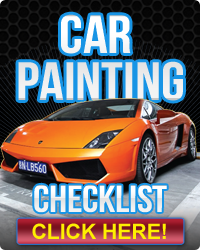Professional Car Painting Tips for the Automotive Collision Technician
Car painting is usually done by a professional auto body shop; the task requires all kinds of special equipment and safety precautions. Whether you’re in training to become an automotive collision repair technician or you are a car owner and simply want to make it a do-it-yourself project, we provide the resources.
Schedule a campus tour at our Exton or Warminster Campus
Car owners that take the proper safety measures and are willing to get very messy and spend a few days on the project can save thousands of dollars by doing the job at home. Plan to paint your car in either a work shed (if your car will fit) or outside, preferably away from trees and during a few sunny days with very little wind. If you want to add any extra designs or graphics in addition to the paint job, make sure you build extra days into the plan.
(Click here for your complete guide to automotive pearl paint)
Also, check with a specialist before mixing any chemicals and to help you figure out the final color. You want to get the right ratios for the mixtures, depending on the size of your car and what you’re trying to accomplish.
You’ll need:
- Plenty of 1200- and 2000-grit wet-and-dry sandpaper
- An electric or air-powered sander
- Masking tape
- Newspapers (for masking off)
- An air compressor
- A spray gun
- A buffer
- Paint thinners
- Facemasks
- Safety glasses
- Undercoat (one or more gallons, depending on the size of the car)
- Topcoat acrylic or enamel paint (three or more gallons, depending on the size of the car)
- Clear-coat lacquer (2-3 gallons or more, depending on the size of the car)
- A dust extractor (not totally necessary, but will help keep the area clean)
If you’ve never used a power spray gun before, you might want to practice the spraying motion on a piece of metal junk before you try it on your vehicle. To apply the paint, hold the spray gun approximately six inches from the surface and spray in a side-to-side sweeping motion. Press the trigger only when you are moving the spray gun. If you press the trigger while the sprayer is still, the paint will be thicker and cause drips.
Here are some basic instructions. Again, you might want to consult with a professional car detailer:
1) Wash the car and hose down the surrounding area. If you plan to paint something with detail on specific areas of the car, block off those areas with the masking tape and paper now.
2) Use the power sander to strip away the old paint, using circular motions. You may have to manually sand the corners and other tricky areas. Go from front to back and make the surface as smooth as possible; the smoother it is, the better the paint finish will be. After sanding, wipe down the whole vehicle completely. Dust, sandpaper remnants, and other debris will cause imperfections in the paint.
3) Mix the primers with the thinners. Apply the primer, working from the roof down. It might take 2-3 coats to cover the car surface completely. Assume 10 minutes per application and 20 minutes of drying time. When dry, the primer will be powdery on the surface so use the 2000 sandpaper to smooth and wipe it down.
4) Clean the spray gun and wipe down the primed surface with a rag slightly dampened with thinners. Note: If you apply too much thinner to the rag, the thinner will strip the primer you just applied.
5) Apply 3-4 coats of the paint with the same sweeping strokes. Again, each coat will take about 10 minutes to apply and 20 minutes to dry. Before applying the final coat, go over the car one last time with the sandpaper followed by a clean rag to get rid of any final residue.
6) Apply the clear coat lacquer.
7) Remove the masking tape while the lacquer is still wet.
NOTE: If you find any problem areas, sand them with the 2000-grit wet-and-dry sandpaper and re-spray.
8) Once everything is dry, buff the whole thing with a soft buffer, using a circular motion. Be careful not to stay in one spot too long, it could ruin the finish.
Sounds doable, right? Auto specialists in training can get more pro automotive painting tips by downloading our free ebook, The ATC Car Painting Checklist.
Have a question? Reach out to our staff at our Exton or Warminster campus.
If you’re interested in learning about what the Automotive Training Center has to offer its students, click here.
More on Car Painting:



